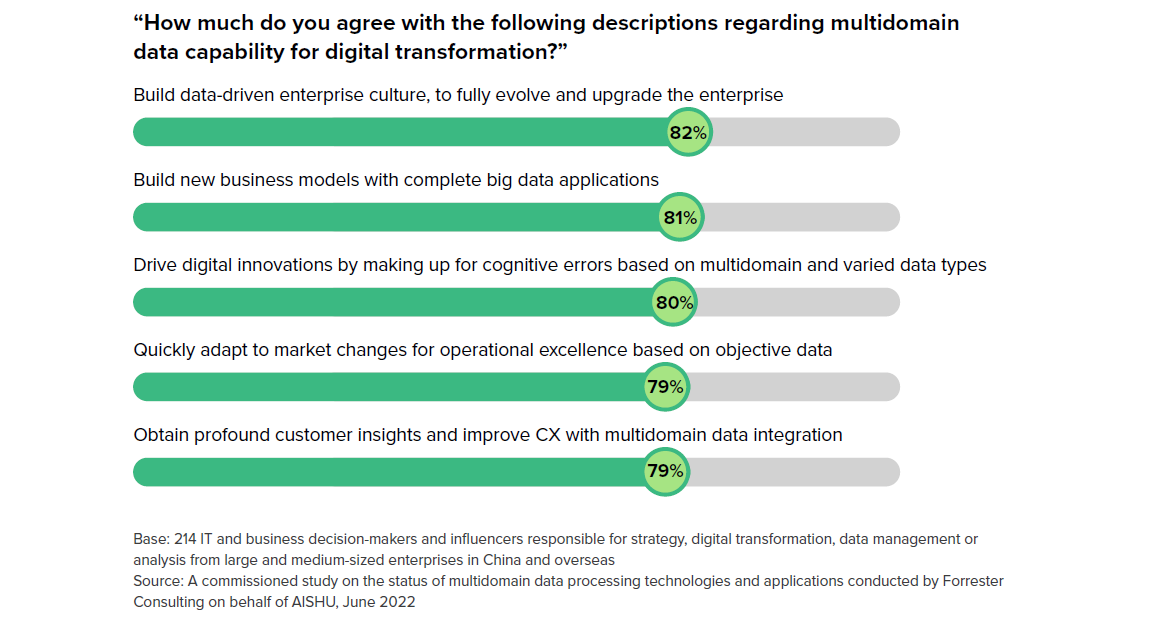
The paper is a product of a survey Forrester conducted with 214 decision-makers from Chinese and overseas large and medium-sized enterprises responsible for planning, building, and managing data platforms. This comprehensive paper highlights the importance of data as a strategic asset in propelling digital transformation and points out the common challenges in upgrading data infrastructure and accelerating data-driven transformation. The report also provides several key recommendations on how enterprises can achieve data-driven operations today.
Enterprises Require Multidomain Data Capabilities for Digital Transformation
There are more and more producers and consumers of enterprise data. Data is not only distributed across different business domains such as R&D, manufacturing, marketing, and management, but is also stored on-premises, off-site, and on cloud. Data types now extend to structured, unstructured, and semi-structured data — thus creating more complications in enterprises. Enterprises need to build a multidomain data landscape and improve its capabilities to support data management, governance, and analysis.
Forrester found that 82% respondents agreed that multidomain data capabilities were significant for digital transformation, not only because data can compensate insufficient knowledge of enterprises, accelerate product and service innovations, and enable them to adapt to intense market competition and evolving customer demands — but also because it can improve CX, help enterprises build brand new business models, and realize operational excellence.

Multidimensional Challenges in Building Multidomain Data Capabilities
Enterprises recognize the value of multidomain data capabilities and have started to integrate multidomain data, introduce technologies to process unstructured and semi-structured data, mine and utilize the value of different types of data, and try to drive insights-driven operation model transformation. However, enterprises still face challenges rising from data strategy, technical tools, organization culture, and process collaboration.
Forrester evaluated the maturity of data-driven operations and innovation at enterprises, and only 28% could consistently utilize insights to drive decisions and actions for all scenarios. This is contributed by a lack of consistent understanding and strategic planning across the enterprise, difficulty in integrating many data silos, lack of collaboration between internal departments, a number of processes with breaking points, and a lack of a complete system to convert data into business value, including mature technologies for processing unstructured and semi-structured data, and professional talents.

Build A New Generation of Data Infrastructure to Accelerate Data-Driven Operational Transformation
Data is both an important asset for enterprise and a production factor for its continuous development, and it should be available to employees, partners, and customers at any time. Technologies for managing, storing, and processing data are critical to support digital transformation and reinventing productivity.
Forrester found that enterprises are modernizing data platforms to realize real-time data insights, support business agility with trusted data, and integrate data across data silos. The technology evolvement of new generation data infrastructure emphasizes more multidomain, automation, data intelligence, and focuses more on business use cases.
Build New Big Data Infrastructure While Focusing on Multidomain Data Capabilities
As data infrastructure continues to upgrade and data capabilities increasingly improve, enterprises also update their cognition. The multidomain data includes integration, governance, and architecture for data across all scenarios, all types and full lifecycle.
- Multidomain data integration
- Multidomain data governance
- Multidomain data architecture
Build New Big Data Infrastructure While Focusing on Key Business Scenarios and Industrial Features
The types of data categories and status of data platform construction varies across industries. Targeted segment business scenarios enable better development routes of modern data infrastructure. In addition, enterprises should focus on business and operation requirements to drive efficient data usage in business and customer insights, quickly realizing the value of data platforms. In our research, we focused on the application scenarios of multidomain data capabilities in biomedicine, finance, high-end manufacturing, and government agencies.
- The biomedicine industry
- The financial industry
- The government
- The high-end manufacturing industry
Create Data-driven Organizations with Data-driven Operations
Based on innovative data fabric architecture, unified ONE architecture and multidomain data capabilities, AISHU comprehensively upgrades its big data infrastructure to help customers cope with the complexity of data management in multi-cloud environments and co-create data-driven organizations.
AISHU's big data infrastructure is oriented to multi-cloud and hybrid cloud environments. Based on data fabric architecture, it converts multidomain data into digital assets, services, and knowledge through different middle platforms, providing data-as-a-service anytime and anywhere, meeting the data-driven needs of various industries and fully unleashing the value of data.

For more information on the research methodology and further insights, download the full report here.
















.jpg)




